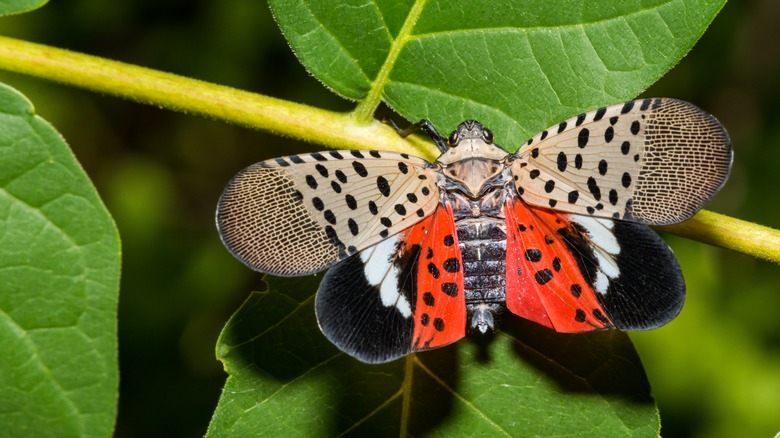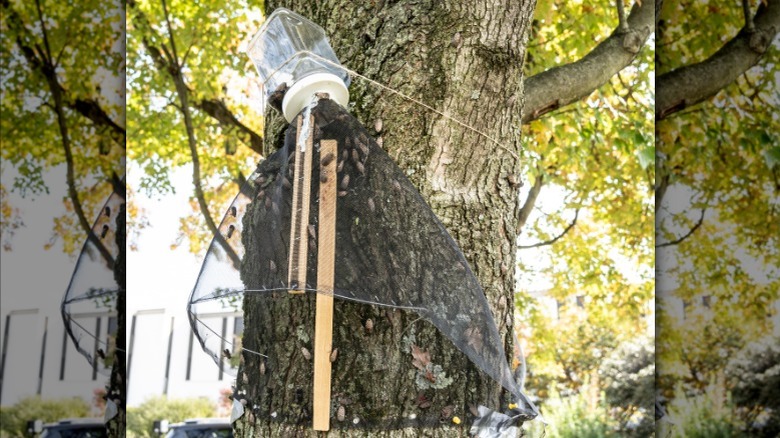DIY A Spotted Lanternfly Trap Before They Become A Nuisance
The 'stomp when you spot' season arrives in late spring. In May, overwintering eggs of invasive spotted lanternflies (SLF) are ready to break out of their muddy shells and scale the length of grapevine, walnut, and maple trees, weakening them. While they don't harm humans or animals, given their propensity for damage, it's recommended to remove trees of heaven to inhibit egg-laying and squish the insects outright if they mature. You can also use insecticides or kitchen items to get rid of spotted lanternflies. However, if you don't want to use these removal methods, trapping their nymphs might be your only option. Although sticky bands or modified pecan weevil traps are available commercially, you can DIY a spotted lanternfly trap for a fraction of the cost. You'll create a frame out of a couple jug tops and an old window screen. The nymphs will crawl up this frame and into a disposable plastic bag, where they'll likely die.
You'll first need to gather the materials and tools, including a standard plastic-coated window screen measuring 30x23 inches. This can be cut down to size depending on your tree's girth. Also, keep two of your empty plastic milk jugs, as you'll need their tops. Next, find two pieces of wood approximating 18x1x0.5 and 11x1x0.5 inches and gallon-sized plastic zipper bags. As for tools, get a 32-inch bendable wire, duct tape, a hot glue gun, a zip tie, a short-staple gun, an office stapler, scissors, twine, and some push pins.
How to DIY a spotted lanternfly trap
Begin by cutting off the tops of both milk jugs and joining their circular openings together using the glue gun. For a stronger hold, wrap the glued section with duct tape. Next, fold two of the screen's corners inwards to meet in the middle. Cut a small semi-circle from the screen's top fold using scissors and discard it. Now, using hot glue, attach the cut-out part of the screen to the interior of one of the milk jugs, ensuring the screen overlaps.
Once the glue is dry, slip the longer wood piece into the screen-covered milk jug. Staple the wood to the screen and plastic holder every few inches using a staple gun. Then, flip the trap over and affix the smaller wood piece to the open flaps using the staple gun, ensuring the flaps overlap to prevent the insects from escaping. Next, attach the wire horizontally along the bottom of the top screen with the office stapler. Make a small cut along the zipper bag's width and secure it to the open milk jug's opening with the zip tie. This makes it easier to swap it out with a fresh bag whenever it's full.
After the trap is complete, tie it around the tree that's seeing spotted lanternfly action with the twine. As for the bottom screen, secure it to the tree with push pins. Finally, push the ends of the wire into the tree to keep the trap open.
Why the DIY trap works
The DIY trap works to get rid of invasive spotted lanternflies because it capitalizes on their typical behavior patterns. After emerging from their shells, the SLF nymphs make their way to their ideal trees for feeding. But being tiny, even a small breeze or obstruction can throw them off the tree's trunk. Surprisingly, this doesn't stop these pesky insects from starting over and continuing to climb up the tree. This makes trapping them easier. With the trap on the tree, the nymphs walk into the tunnel and eventually move into the zipper bag, which acts as a collection center, suffocating them in it. Interestingly, as the bag reflects light, it fascinates and further pulls in SLF nymphs. However, if you don't want to use a bag, you could modify the DIY to feature a plastic container instead.
This isn't a novel concept, as sticky bands work on a similar principle. However, unlike their adhesive-laden counterparts, this DIY trap is less likely to harm birds and other beneficial pollinators. Besides, the traps are more effective, as they target even the near-maturity, late-stage nymphs. To boot, as their container bag fills up, the trap tips to the other side, allowing more insects to walk to an early death. However, to ensure the trap works as desired, ensure the tree's trunk or limbs aren't deeply furrowed so the SLFs can't climb underneath the window screen.

